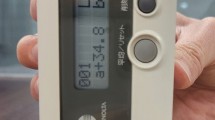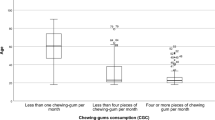Abstract
This study was conducted to compare subjective and objective assessment methods of a two-colored chewing gum test and to find out whether these methods are capable of discriminating masticatory performances between sexes. 31 adults, 16 males and 15 females participated in this study. Each subject chewed five samples of two-colored chewing gum sticks for 5, 10, 20, 30 and 50 chewing strokes, respectively. The subjective color-mixing and shape indices for the gum bolus (SCMI-B, SSI-B) and the subjective color-mixing index and objective color-mixing ratio for the gum wafer (SCMI-W, OCMR-W) were evaluated by two independent examiners and, on a different day, re-evaluated by one of the examiners. The SCMI-B and SCMI-W assessments had inter- and intra-examiner reliable agreement at 20 or more chewing strokes. The OCMR-W measurement demonstrated high accuracy and low reproducibility between and within the examiners. There were significant gender differences in the distribution of SCMI-W scores (P = 0.044) and in the mean OCMI-W (P = 0.007). The SCMI-B and SCMI-W assessments and the OCMR-W measurement were reliable and valid at the 20 and 30 chewing strokes in this two-colored chewing gum test. The subjective color-mixing index (SCMI-W) and objective color-mixing ratio (OCMR-W) for the chewing gum wafer are capable of discriminating masticatory performance between sexes in this two-colored chewing gum test and that the OCMR-W measurement is discriminating better than the SCMI-W assessment.


Similar content being viewed by others
References
Magalhaes IB, Pereira LJ, Marques LS, Gameiro GH. The influence of malocclusion on masticatory performance: a systematic review. Angle Orthod. 2010;80:981–7.
Bates JF, Stafford GD, Harrison A. Masticatory function—a review of the literature. III. Masticatory performance and efficiency. J Oral Rehabil. 1976;3:57–67.
Van der Bilt A, Olthoff LW, Oosterhaven SP. The effect of missing postcanine teeth on chewing performance in man. Arch Oral Biol. 1993;38:423–9.
Julien KC, Buschang PH, Throckmorton GS, Dechow PC. Normal masticatory performance in young adults and children. Arch Oral Biol. 1996;41:69–75.
Toro A, Buschang PH, Throckmorton G, Roldan S. Masticatory performance in children and adolescents with Class I and II malocclusions. Eur J Orthod. 2006;28:112–9.
English JD, Buschang PH, Throckmorton GS. Does malocclusion affect masticatory performance? Angle Orthod. 2002;72:21–7.
Sato H, Fueki K, Sueda S, Sato S, Shiozaki T, Kato M, Ohyama T. A new and simple method for evaluating masticatory function using newly developed artificial test food. J Oral Rehabil. 2003;30:68–73.
Lucas PW, Luke DA. Is food particle size a criterion for the initiation of swallowing? J Oral Rehabil. 1986;13:127–36.
Shiere FR, Manly RS. The effect of the changing dentition on masticatory function. J Dent Res. 1952;31:526–34.
Liedberg B, Spiechowicz E, Owall B. Mastication with and without removable partial dentures: an intraindividual study. Dysphagia. 1995;10:107–12.
Schimmel M, Leemann B, Herrmann FR, Kiliaridis S, Schnider A, Muller F. Masticatory function and bite force in stroke patients. J Dent Res. 2011;90:230–4.
van den Braber W, van der Glas H, van der Bilt A, Bosman F. Masticatory function in retrognathic patients, before and after mandibular advancement surgery. J Oral Maxillofac Surg. 2004;62:549–54.
van den Braber W, van der Bilt A, van der Glas H, Rosenberg T, Koole R. The Influence of mandibular advancement surgery on oral function in retrognathic patients: a 5-year follow-up study. J Oral Maxillofac Surg. 2006;64:1237–40.
Schimmel M, Christou P, Herrmann F, Muller F. A two-colour chewing gum test for masticatory efficiency: development of different assessment methods. J Oral Rehabil. 2007;34:671–8.
Liedberg B, Owall B. Masticatory ability in experimentally induced xerostomia. Dysphagia. 1991;6:211–3.
Liedberg B, Owall B. Oral bolus kneading and shaping measured with chewing gum. Dysphagia. 1995;10:101–6.
Prinz JF. Quantitative evaluation of the effect of bolus size and number of chewing strokes on the intra-oral mixing of a two-colour chewing gum. J Oral Rehabil. 1999;26:243–7.
van der Bilt A, Mojet J, Tekamp FA, Abbink JH. Comparing masticatory performance and mixing ability. J Oral Rehabil. 2010;37:79–84.
Sato S, Fueki K, Sato H, Sueda S, Shiozaki T, Kato M, Ohyama T. Validity and reliability of a newly developed method for evaluating masticatory function using discriminant analysis. J Oral Rehabil. 2003;30:146–51.
Speksnijder CM, Abbink JH, van der Glas HW, Janssen NG, van der Bilt A. Mixing ability test compared with a comminution test in persons with normal and compromised masticatory performance. Eur J Oral Sci. 2009;117:580–6.
van der Bilt A, Speksnijder CM, de Liz Pocztaruk R. Digital image processing versus visual assessment of chewed two-colour wax in mixing ability tests. J Oral Rehabil. 2012;39:11–7.
Wilding RJC, Lewin A. The determination of optimal human jaw movements based on their association with chewing performance. Arch oral Biol. 1994;39:333–43.
Landis RJ, Koch GG. The measurement of observer agreement for categorical data. Biometrics. 1977;33:159–74.
Othman S, Harradine N. Tooth size discrepancies in an orthodontic population. Angle Orthod. 2007;77:668–74.
Conflict of interest
The authors declare that they have no conflict of interest.
Author information
Authors and Affiliations
Corresponding author
Rights and permissions
About this article
Cite this article
Endo, T., Komatsuzaki, A., Kurokawa, H. et al. A two-colored chewing gum test for assessing masticatory performance: a preliminary study. Odontology 102, 68–75 (2014). https://doi.org/10.1007/s10266-012-0089-7
Received:
Accepted:
Published:
Issue Date:
DOI: https://doi.org/10.1007/s10266-012-0089-7




